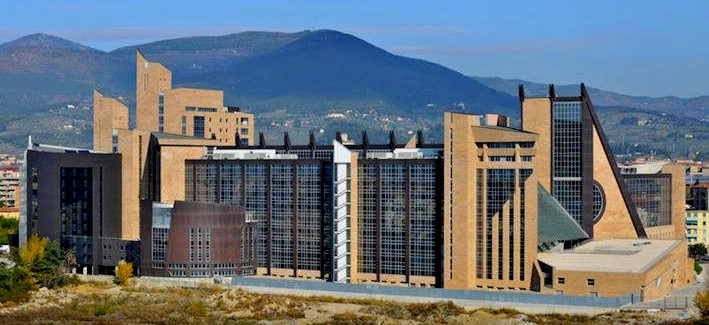
Tuesday, November 05, 2013
RS And AK Seemingly Competing To “Appropriate” Meredith: Ghoulish, Sadistic And Very Cruel? Or…?
Posted by Our Main Posters
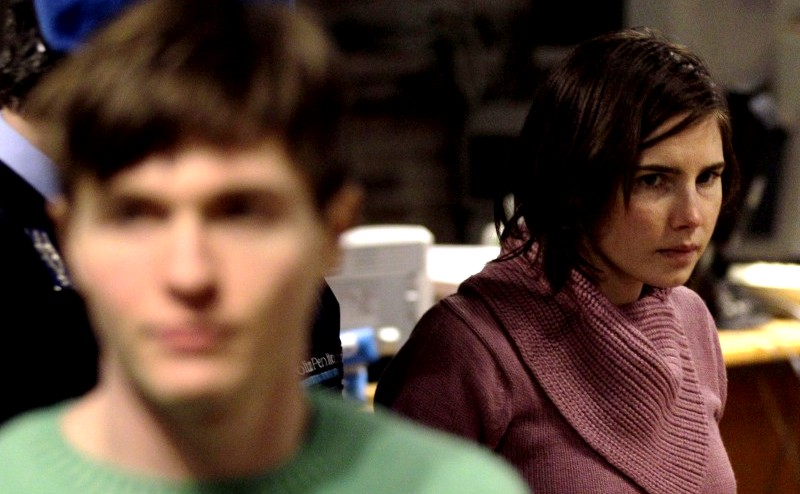
Amanda Knox has stated several times on national TV that she would like to visit Meredith’s grave.
Meredith’s father responded very firmly that this was quite out of the question. The family will never approve. Perhaps predictably, Raffaele Sollecito then announced triumphally that he had already been.
We can be sure that this exchange will do them no good at all in the Florence court, where the prospects of Judge Massei’s special considerations (which lopped five years off their sentences) being re-allowed by the Nencini court now seem pretty dim.
Other than as a ghoulish competition, can this be seen any other way? Last Saturday, Skeptical Bystander, no great lover of the perps, aired the suggestion that we might be seeing a new psychological phase coming into play
Skeptical Bystander
My thinking has evolved somewhat about the report that RS visited Meredith’s grave, as well as about AK’s non-stop chatter about doing so with the Kerchers and her grotesque appropriation of Meredith.
I just caught part of a documentary treatment of the Menendez case, wherein two brothers, Lyle and Eric, killed their parents. Both were sentenced to life in prison. In a probation report, Lyle is quoted as saying he has found peace by visiting his parents’ grave, asking for forgiveness, and understanding that they have forgiven him.
It is entirely possible that both AK and RS want forgiveness from Meredith and from her family. What they don’t seem to realize is that they can’t take shortcuts or be given a free pass. Lyle Menendez got sentenced for his crime and began the process of self-examination that leads to accountability.
We asked two of our posting psychologists if we could indeed be seeing something like this. With their agreement, this is their email exchange, in which they both concede that Skeptical Bystander may have had a point:
Psychologist A:
It is entirely probable they want, indeed crave, ‘forgiveness’. The problem is that dysfunctional or disturbed personalities may be able to be aware of their guilt, but not of their shame.
The guilt would want the forgiveness, but the process that leads to the resolution that is forgiveness will not occur - indeed I believe cannot occur- until the shame is ‘owned’.
Just judging from Raffaele’s and Amanda’s faces alone, I would estimate that Raff is slightly nearer than Amanda in approaching his own shame. Unfortunately I see zero in Amanda, and therein lies the huge problem.
If someone lacks sincerity, someone else or circumstances cannot make them more sincere - what I call authentic. It has to come from self-realization.
That’s my ‘take’!
Psychotherapist B:
At a certain point, this is all just speculation about someone I’ve never met, so it’s hard to say one way or another.
My best guess would be that in this case neither Knox nor Sollecito has shown any public signs of really being able to admit to themselves that they’ve done anything to be sorry for.
For what it’s worth, my overall impression, based on what’s been made public, is that Knox would likely not ever have killed anyone if she hadn’t been high and in an especially reckless period of her life and influenced by meeting Sollecito.
She might have gone on being somewhat impulsive and aggressive without ever actually harming anyone, and with luck she might have outgrown it in a few years. I think the kind of cruelty we’ve seen in this case is driven by unconscious feelings and motives.
Clearly it pains her to be seen as guilty; the idea that anyone can think that about her bothers her a lot. It’s easier for me to picture her wanting a visit to Meredith Kercher’s grave to somehow clear her of all of this upsetting suspicion, than truly wanting Meredith’s forgiveness - more wanting to get rid of shame than to atone for guilt or repair harm, if that makes sense.
When I think of forgiveness, I think of a more mature kind of experience. It takes maturity and integrity to own that you’ve done something harmful, to withstand whatever feelings of shame and guilt the realization brings, and to seek to make actual reparation.
But anyone can feel haunted by having done a bad thing, and want someone to take the haunting away. I’m reminded of Bill in Oliver Twist - after he kills Nancy he feels sorry for himself and overwhelmed by the fear of retribution, but you couldn’t say he’s exactly seeking forgiveness - well, maybe a two-dimensional version of it.
Psychologist A:
Yes, quite right. It is all dreadfully disheartening, and still shockingly cruel.
I agree deeply about the unconsciousness of what is going on. One would expect immature adolescents to be acting a lot from their unconscious, and one of the troubles with the joint denial of events is that they are preventing themselves (and others) from growing or becoming more conscious, but instead ‘freezing’ themselves at that awful time 6 years ago.
You: “He feels sorry for himself and overwhelmed with the fear of retribution, but you couldn’t say he’s exactly seeking forgiveness—well, maybe a two-dimensional version of it. “
I see true forgiveness as a powerful phenomenon which occurs at a crucial stage of a healing process. I think it is something that occurs, that happens to one, is experienced, and is far greater than anyone’s ego.
I would think that someone who had hardly begun, or who had not at all commenced, upon this process would actually have no idea about what forgiveness might actually look or feel like, or be, in fact - let alone how to arrive at it.
Their consequent confusion might then manifest in ,as you say, wanting a two-dimensional version of it, that could be summed up as merely ‘not wanting to be seen as bad’. So perpetuating the ‘good image(s)’ of themselves, which is a gross evasion.
They certainly want not to be hated, as probably anyone does. But it is a huge chasm to actually doing something about that, and learning to behave in a way that people with conscience find acceptable.
Psychotherapist B:
I think you’re absolutely right about forgiveness - thank you for saying it so well.
Appeal Court Sessions This Wednesday And Thursday Dont Look Very Promising For The Defenses
Posted by Peter Quennell
Expected proceedings and backdrop
The Carabinieri DNA report will be the main item and after an interruption from Sollecito we could see the final summations begin.
It is hard to believe that Doug Preston and other deniers of the plain facts have exulted in recent months that the Florence prosecution and court could be a big plus for the perps in their appeal. Presumably their joy was based on highly out-of-date takes on the 2010 move against Dr Mignini by a rogue Florence prosecutor in front of a rogue Florence judge.
Well, guess what? Both have been edged aside (like Hellmann and Zanetti), and the Florence Appeal Court and the Supreme Court have scathingly reversed Dr Mignini’s (and Dr Giuttari’s) faux conviction. And despite some ill-advised smearing still emanating from the Fischers, Moores, and other Knox parasites, Dr Mignini and his colleagues are seeing their careers and popularity (and 2009 success) riding very high.
Judge Nencini and Prosecutor Crini are both hardened anti-Mafia battlers, and the not-so-hidden hand of the mafia in the Italian media campaign to poison public opinion against the court will not have escaped their attention for sure.
At least half a dozen of the parties on the defense bandwagon are known fellow-travelers of the mafia, and at least two are already headed for court - Luciano Aviello is already there for obstruction of justice, and Mario Spezi is headed there soon for a false and very elaborate framing of murder, a charge which could put him (and maybe Preston) away for a long while. The editor of Amanda Knox’s favorite mouthpiece, Oggi, is another we may see.
The same Florence prosecutors and courts will also be putting Frank Sforza on trial starting this wednesday with a preliminary hearing at which the details of the charges against him will enter the public domain. We will post then at more length. Our past commentary on Sforrza can be read here.
Frank Sforza has been a very close ally of some of the more hotheaded and misleading Amanda Knox supporters (both the Mellases, Steve Moore, Bruce Fischer, Michael Heavey, among others) and if he squeals to keep himself safe and out of jail, their own legal fortunes could take a big fall.
Frank Sforza is also required to appear for trial both in Perugia and Seattle, in both jurisdictions for physical abuse. If he fails to show in Florence (his Rome address is quite well known) we expect to see him nabbed by the police and sent on his way in handcuffs to all three trials.
The same Florence prosecutors and courts are also contemplating new charges against Raffaele Sollecito and his publishing and PR bandwagon for the wild claims in his book, which were designed to poison public opinion agains the court and make him a ton of money. Those claims are a real minefield for Sollecito when he gets up and talks as they conflict both with what his team has said in court and what Knox said in her book.
Knox’s book, which was also designed to poison public opinion against the court and make her a ton of money, is being investigated by the chief prosecutor in Bergamo up north. At a minimum, the Florence prosecutors and judges will already know of this attack on the chief prosecutor which seems enough for a guilty verdict all by itself.
Contexting the DNA report
The main findings of the Carabinieri labs were summarised in the post directly below.
This further take on the context, and on who is up and who is down, was kindly contributed by one of our Italian court-watchers, who has many connections in Florence and Rome, and who sees the prosecution DNA teams as riding high now, and the defense forces and Vecchiotti and Conti as left with with no place to hide.
Dr. Barni and Dr. Berti, the two court-appointed Carabinieri RIS experts, are the authors of various internationally-circulated articles about presumptive blood tests, where they prove the opposite of some of the things the Sollecito—Knox sycophants deny. For example that bleach does decompose quickly when exposed to air and does not react to luminol after some 1-2 days.
Patrizia Stefanoni also has respected publications as a scientific author. In fact, in 2011 she was in the top 25 hits of forensic science with her publications, she has been even in first place with this report.
The Carabinieri RIS note that the refrigerator has no temperature log; from this detail, albeit small within the overall report, we can deduce that Vecchiotti’s laboratory cannot have had ISO 9001 certification or any other international certification, given that the standards would require a temperature log. Apparently the refrigerator doesn’t have an accurate thermometer either, since the Carabinieri measured the temperature using one of their own.
Another detail noted at the beginning is this: the Carabinieri RIS expected the sample volume to be 24 microliters, since this was the remaining volume declared by Conti and Vecchiotti, while Barni and Berti found it to be only between 16 and 17 microliters. They infer that Vecchiotti and Conti might have been inaccurate on the estimation of the remaining amount after quantization, or hypothesize that the content might have evaporated over the last two years because the samples were not wrapped inside a protective film.
Vecchiotti and Conti had been already discredited, and have no credibility in the present appeal trial. However, the RIS finding might deliver a further blow to whatever might be their residual credibility. They had already previously been completely discredited because:
1. They were appointed by judges who are now completely discredited, whose conduct was found illegitimate for reasons of unprecedented gravity, and who received a devastating bashing from the Supreme Court;
2. Vecchiotti and Conti were also discredited by Prosecutor Manuela Comodi in her court cross-eamaination in 2011, as the speciousness and falsehood of their arguments was exposed (this was the famous hearing where they claimed contamination on the ground that “everything is possible” and where Vecchiotti admitted she didn’t request negative controls)
3. Vecchiotti and Conti were discredited scientifically by Novelli’s argument, as he explained that they should have tested the 36-I sample, and as he also explained that that he found no trace of contamination in the Scientific Police laboratory’s work, or any reason to suspect contamination of Meredith Kercher’s DNA, and he explained that attribution could be done accurately based on bio-statistical calculation without requiring a second confirmatory test.
4. Finally, Vecchiotti and Conti were egregiously discredited by the Supreme Court which addressed a manifest issue in their “intellectual honesty”. Here is the Supreme Court ruling, page 65: ” ... a member of the panel of experts could not assume any responsibility for unilaterally narrowing the scope of the mission, which was to be carried out without hesitation or reservation, in full intellectual honesty, giving a complete account of the possible insufficiency of the material or unreliability of the result. (...) “The court mentions sardonically the judge-appointed expert’s “intellectual honesty”, and that is a very striking comment when found in a Supreme Court ruling: since the Cassazione is not a fact-finding panel, they don’t write about factual conclusions unless they appear prima facie as manifest and undisputable.
So the Supreme Court considers there are problems of intellectual honesty in the work of Vecchiotti and Conti, something manifest and obvious; the Court acknowledges they are obvious, something that anyone can see, which does not require a fact-finding by a judiciary organ to be pointed out.
Now the Carabinieri RIS report may bring further discredit upon Vecchiotti and Conti, if they have any credibility left. There are at least two reasons for this:
1) Because the finding of a reliable DNA profile belies the assessment that was given by Vecchiotti and Conti that extraction of a profile would be impossible, and demonstrates that in fact it was possible to extract a reliable profile; incidentally the fact that a Carabinieri RIS test was ordered itself implicitly denies Hellmann-Zanetti’s assessment that any result from 36-I would anyway be useless because contamination could have occurred outside the laboratory; but also it credits Novelli while it discredits Veccchiotti and Conti on a scientific level, because it explicitly denies the idea that small (Low Template) DNA amounts are unreliable.
2) Because the Carabinieri RIS test employs the method proposed by Novelli, that is to couple Stefanoni’s “˜biologic’ analysis method with the statistical probability assessment method, in order to come to a certain attribution. Moreover, the Carabinieri RIS also point out that they can do this by assessing only 11 loci from a complex trace which also has foreign alleles (whereas trace 36-B analysed by Stefanoni was a “˜clean’, non-mixed profile matching a 17-loci sequence).The Carabinieri RIS ran the test in “˜duplicate’ while Stefanoni made a single profile extraction. The Carabinieri point out that they can do this ““ divide even a smaller and more complex trace, and test it for comparison even on a smaller number of loci - because they now have “a system with extremely higher analytical performance which is able to provide result quantitatively and qualitatively better compared to previous systems”.
Sunday, November 03, 2013
Knox Apologists Attempt To Bend Congress; But Nobody Important Turns Up
Posted by Our Main Posters
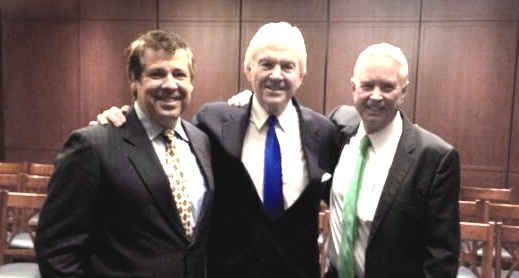
From the left: Steve Moore, John Douglas, and Michael Heavey.
In a room for hire at the Congress they made presentations of their misleading takes on the case to a near-empty room.
Senator Cantwell was apparently there briefly but took off as soon as she could. No other elected leaders were seen to be there.
There was seemingly no media coverage except for a sole post by another Knox apologist on the Infamous Ground Report.
These are hardly the most impartial or for that matter truthful and accurate observers of the case.
Click through for our numerous takedowns of the hapless Steve Moore, and John Douglas, and Michael Heavey.
Thursday, October 31, 2013
Why DNA Test Results 6 November May Leave No Further Argument Over Knox And Sollecito Guilt
Posted by Peter Quennell
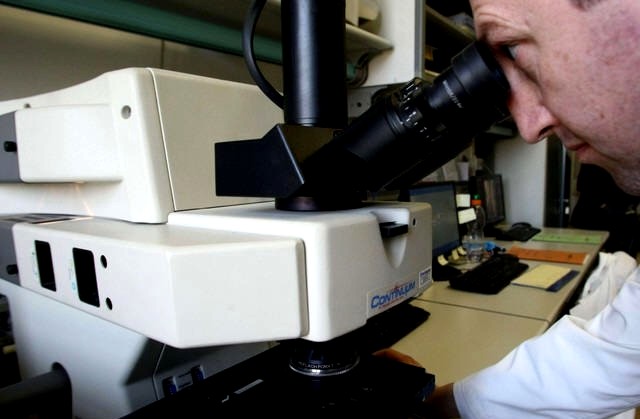
[Above: an image of similar testing in the same Carabinieri laboratory in north Rome]
The official results of the tests by the Carabinieri laboratory will be made public by Judge Nencini in court on 6 November.
The report and attachments are reported to be more than 100 pages long. Andrea Vogt has already warned that no assumptions should be made yet that we know the full story. But already for the defenses, matters do not look pretty.
- 1) It sounds like the result of the DNA near the top of the blade (see images below) shows conclusively that it is another sample of Knox’s DNA. Given where the sample came from it could be blood DNA and add further proof to the notion that Knox was injured while struggling with Meredith.
2) The low-copy-number amplification technique used was almost identical to that used by Dr Stefanoni to prove that it was Meredith’s DNA on the blade of the knife - actually that was a larger sample. Judge Massei’s court accepted this, Judge Hellmann’s consultants tried very hard to undermine it, and the Supreme Court ruled that they did not even come close.
Earlier this year, our main poster Fly By Night in a post worth re-reading explained just how conclusively the results of that first testing pointed to both Meredith and Knox.
As is typical of all DNA analyses, Stefanoni proceeded to amplify the results to a point where an electropherogram would reveal meaningful “peaks” and found that a resultant 13 pairs of peaks corresponded precisely to peaks derived from a known sample of Meredith Kercher’s DNA!
In this case it is pointless to attempt to argue that Stefanoni somehow exceeded the amplification limits of her equipment. As outlined in the DNA discussion above, the typical problems associated with an amplification of low levels of DNA are related to peak imbalances, enhanced stutter, allele drop-outs, or allele drop-ins.
In this case there was nothing but a perfect match for Meredith that even Carla Vecchiotti and Stefano Conti could not deny in court.
Stefanoni had clearly identified an identical match for Meredith’s DNA on the blade of Sollecito’s kitchen knife, leaving Vecchiotti and Conti no other option than to argue for “contamination” in court.
However, it was convincingly demonstrated by Stefanoni and all evidence handlers that from knife collection through laboratory analysis no reasonable opportunity for contamination with Meredith’s DNA existed.
Dr Stefanoni’s testing of all the DNA from the crime scene was done in front of some defense observers. Those who were there saw her do nothing wrong. Dr. Patrizia Stefanoni, Dr. Renato Biondo, Professor Giuesppe Novelli, Professor Francesca Torricelli, Luciano Garofano, Elizabeth Johnson and Greg Hampikian have all confirmed that Meredith’s DNA was on the blade of the knife.
It looks as if the prosecution has now achieved a clean sweep of all of the of DNA testing. Meredith’s DNA on the lower blade of the knife seems even more conclusively a firm given, and so does Knox’s on the upper blade and the handle.
We are where we were back in 2008 before trial, where other defense lawyers might have suggested to their clients to select a trial of the short form type - the same choice that will see a somewhat penitent Guede out on work release in two years, no more.
But instead, their clients could now be facing life sentences for that bad choice.
Image: looking along the blade toward the handle, both sides of the knife
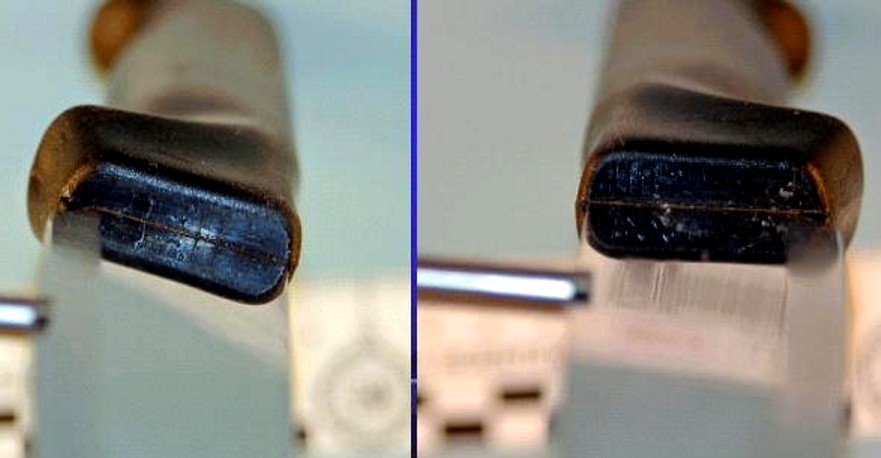
Here is an image showing the I trace in the location described in the post with credit to Iodine of PMF and the Case Wiki
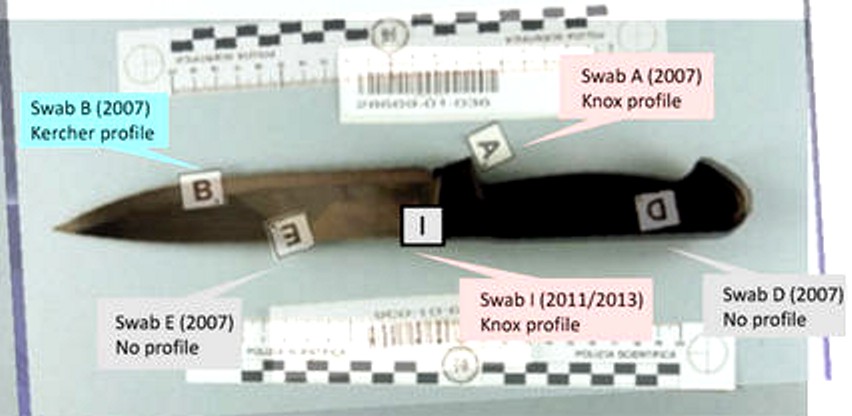
Monday, October 28, 2013
Some Hard Truths Sollecito PR Puppet Sharlene Martin Omits In Her Misleading Invite To The Congress
Posted by Our Main Posters

Dear Sharlene Martin:
Please dont say we didnt warn you before. In this notice of a Congressional “briefing” (read: paid highly misleading PR) you once again gloss over a number of hard truths.
You might well be advised to head to higher ground. The US Congress and the Administration will soon be left in no doubt about the correct facts of the case against Sollecito and Knox, as Italian law enforcement start to reach out to their counterparts in the FBI, and as they charge mischief-makers with obstruction of justice in the case, and as more and more reporters in the US and UK media wisen up.
Against your client, this was always a very strong case. And this alone has your client cooked. Here are some other corrections and correct background to the false claims you have just made.
- 1) Senator Cantwell was already burned by associating too closely with your radioactive group. She spoke out daffily for Amanda Knox several years ago - and then, duly warned, she went quiet again. Ask her congressional staff for the story to that. And read our past heads-ups for Senator Maria Cantwell here and here.
2) Your client Raffaele Sollecito wrote the most defamatory and misleading book about an Italian case in many years. Key claims have been repudiated by his own father on Italian TV. As his case is ongoing Sollecito is meant to fight it in the (very fair) Italian courts, not poison public opinion to lean on those courts. Sollecito is being considered for charges of obstruction of justice for the book and much else in the media, and you and the publishers may be charged too.
3) This is NOT a third trial. It is a re-run of a first appeal. If the very well-run and highly decisive Massei trial of 2009 had been run in the US or UK it is hard to see what grounds if any, any appeal judge would accept for appeal. Your client would be near the end of his sixth year in prison. And it is known that the Hellmann Appeal and the DNA consultancy were both bent by Sollecito’s and Knox’s own teams (corrective measures have been taken with more to come) so the 6-year process is essentially your own team’s fault.
4) John Douglas’s highly self-serving chapters on the case are among the silliest ever written in a crowded field. The very vain Douglas starts with the totally false premise that Knox was forced to confess after many many hours, and from there on out it is all downhill. He takes a faux position essentially identical to that of Saul Kassin. Read about Kassin’s own spurious and highly self-serving take on Knox’s “forced confession” here and here and here.
5) Steve Moore lacks the correct expertise to analyse this case and he was never the ace crime scene investigator you claim. A dozen or more posts here show how unreliable and rambling he is. Among other things he appeared on a disastrous panel (with a team almost identical to yours - and an audience that peaked at 35) at Seattle University a couple of years ago. Read what two very astute lawyers thought of his man-in-a-bubble performance here and here.
6) The hapless Michael Heavey was officially reprimanded for his bizarre intervention in the case. He was also on the disaster of a panel at Seattle University. He has got the basic facts wrong again and again and again. Here he is getting the facts wrong five years ago. Here is his association with Frank Sforza, a key mis-stater of the key facts of the case and serial defamer of the Italian officials involved, who he was financially supporting - and who now faces three separate trials of his own.
7) And the hapless John Q Kelly? This is a tough field in which to come out ahead but John Q was perhaps the silliest talking head for Knox and Sollecito on TV. He babbled on in the media about a railroading that never took place. Read how even his own colleagues considered him to have been duped here and here.
A Congressional briefing panel that is not made in heaven, that is for sure. Stay tuned. There is more to come.

Tuesday, October 22, 2013
The Meredith Case Wiki: A Highly Objective Summation Of The Case From Original Docs And Transcripts
Posted by James Raper

Some of our readers may not have noticed the new link to The Meredith Case Wiki to be found in the left hand column of this front page. I had not noticed it myself until recently.
This is an important link to a new website that is now a vital additional resource for those interested in understanding this case.
The website - The Murder of Meredith Kercher - is run by Edward McCall, with the assistance of other contributors, and TJMK is pleased to acknowledge and promote its distinctive and concise approach to presenting the facts of the case.
The site is modelled on the format of a page from the Wikipedia free encyclopedia. As with a Wiki page it is easily navigable. The data presented under the various headings is the consequence of much research but it still remains a work in progress. Wherever possible the material used is referenced in footnotes.
It starts on the Main page with a Mission Statement and an Introduction to the case. It then considers the evidence and has a good section entitled Myths Debunked.
The reader can easily access significant court documents: the Massei Report, the Hellmann Report, the Galati Appeal and the Supreme Court of Cassation Motivations Report. There is an accessibly summary of the Matteini and Micheli Reports.
In particular, for the researcher, there is a most welcome section entitled Court Transcripts. Here can be found transcripts of witness testimony from the Massei and Hellmann trials, experts reports, and the various writings and testimony of Amanda Knox, Raffaele Sollecito and Rudy Guede. At least that is to be the hope ultimately as there exist a good number of gaps at present.
Already some of the witness statements have been translated from Italian to English but there are a number of transcripts still to be translated. If there are any translators who would wish to help, please contact us and we shall be pleased to put your name forward.
McCall wishes to acknowledge the massive contribution made by True Justice for Meredith Kercher. TJMK has perforce grown organically and exponentially over the years and has accumulated a breadth and wealth of data, in-depth analysis and informed comment on the case which is unsurpassed on the internet, or indeed anywhere.
It will continue to do so and report developments until the conclusion of all aspects of the case.
Sunday, October 20, 2013
Given The Abundant Facts, What Scenario Is The Nencini Court Considering? Probably Not Unlike This
Posted by Marcello

1. The “Innocence/Framing” Campaign
It is rather sad that this case, of the violent murder of Meredith Kercher, has seen a ‘hurricane’ of noise trying to cherry-pick and disprove the more salient facts, and worse, discredit those who investigated, prosecuted and ruled on the case as well as discredit those who continue to emphasize the facts.
Over the past six years there has been a concerted effort by the defendants in this case, and primarily by their families, their “˜groupies’ and their legal consultants, to mount and continue a public relations campaign to frame the defendants as innocent of the crime of murdering Meredith Kercher. This ‘innocence’ campaign has even gone so far as to tarnish the motives of the fine justice officials involved.
The defendants themselves have continuously obfuscated and lied about the more salient facts, albeit inconsistently (their multiple versions fail to match up, and do not match the available facts). Lately Ms. Knox has done a number of (typically unconvincing) interviews, and her parents still seem too intent on defending the fantasy of their daughter’s innocence, all evidence to the contrary.
Mr. Sollecito, for his part, tweets unofficial retractions about statements he made in court. Both have distastefully profited through books that are not much more than a compilation of lies (and which do not offer matching alibis). Meanwhile the legal teams for the defendants have recently leaked “˜favorable’ results from the testing of a new sample on the presumed murder weapon in order to (again) misconstrue the evidence for the general public.
2. Media Misreporting Facilitates
Perhaps the most unfortunate aspect of this “˜innocence campaign’ has been that far too many journalists have dishonored their professional ethics by failing to do the proper research and objectively report the facts. Journalists to this day continue to misreport the facts, leave out corroborating facts, or worse, blindly repeat the distortions or lies promoted by the campaign without proper fact-checking. By and large, journalists (mostly in the US and UK) have ‘anti-reported’ the case.
This is especially grievous given that there are multiple Court Motivations reports (a unique feature to the Italian justice system) readily available in Italian and English online, in searchable PDF format, as well as several websites like this one that have painstakingly sought to illuminate the vast amount of evidentiary facts.
Those journalists who have failed to correctly report the case, and those involved in this ‘innocence’ campaign, have repeatedly disrespected the victim, Meredith Kercher, and her family. By contrast, the Kerchers has shown great dignity throughout these years, remaining patiently quiet and consistently insisting that the truth be revealed by the Italian justice system.
The endless journalistic failures, and particularly the ‘innocence’ campaign, have also disrespected the Italian law enforcement and judicial systems. By contrast Italian law enforcement has demonstrated substantial deference to the defendants, especially when compared to the law enforcement and judicial procedures of other advanced countries. In response, numerous ‘groupies’ have exhibited pathetic jingoism by repeatedly denigrating a country of 60 million people based on rather uninformed attitudes.
And it is very likely that Ms. Knox and Mr. Sollecito, rather than confess the truth, will continue to obfuscate or lie as much as they can, as well as disrespect the Italian Court and the Kerchers by not being present at the appeal. Their ‘innocence’ campaigns will likely continue to distort or ignore the facts. And worse, journalists and talking-head ‘experts’ will continue to report falsehoods and misrepresentations.
3. All Will Now Be To No Avail
Fortunately, none of the fabrications, ill-conceived scenarios or numerous pieces of unprofessional, sloppy journalism will ultimately matter.
This is because the Nencini Appeals Court will not be listening to any of the noise. The Appeals Court has a very specific program to follow, mandated by the Italian Supreme Court, which has already looked at this case four times (the detainment requests for Knox and Sollecito, the conviction of Rudy Guede and the annulment of the Hellmann Appeals Court ruling). The Nencini Appeals Court program includes:
- 1) looking at all the case evidence noted in Judge Massei Trial Court’s Motivations report,
2) considering the Italian Supreme Court’s Motivations report for the conviction of Rudy Guede, in which Guede was convicted of having a role in Ms. Kercher’s murder, but not the key role of fatally stabbing her, and that he acted in concert with others, and
3) considering Ms. Knox’s voluntary “˜gift’ statement of November 6, 2007, in which she placed herself at the scene of the crime. (This statement follows an earlier verbal and written statement released to the police during a few hours of interrogation in the early hours of November 6th.)
4. Big Surfeit Of Evidence
The amount of evidentiary facts the Nencini Appeals Court will have absorbed is substantial. Unlike the Hellmann Appeals Court, they cannot cherry-pick the facts. Per the Supreme Court, they must consider all the available evidence as a whole, logically tied together like a mosaic. Significantly, one could even leave out the knife and bra clasp entirely as evidence points because:
- 1) Ms. Kercher was murdered by more than one assailant. This is evident from the wounds she suffered, from the evidence in general and has been consistently maintained by three different trial judges and four different Supreme Court reports.
2) Guede in all his various confessions has consistently hinted and ultimately confirmed the presence of Knox and Sollecito during the crime.
3) There is no plausible scenario for the crime that involves Guede and two or more unknown assailants.
4) All the other evidence found at the crime scene points to Sollecito and Knox being present before, during and after the crime in some fashion.
5) Knox was at the scene of the crime by her own written admission.
6) The break-in was staged and, by obvious implication, only Knox and Sollecito would have any interest in staging the break-in (see my earlier post listing all the problems with the break-in scenario).
There seems no rational way that the Nencini Appeals Court can logically acquit. And Judge Nencini has not ‘pre-announced’ a non-guilty verdict like Judge Hellmann did by claiming that the defendants “˜appear to be innocent’.
The only remaining questions are what kind of dynamics will the Nencini Appeals Court assign to the participants, and what kind of reasoning will the Italian Supreme Court provide, assuming Knox or Sollecito appeal to the Supreme Court.
Having already read the Massei Motivations report and supporting documentation for weeks, this will already be a highly informed judges’ panel. What scenario are they converging on? The following scenario is based on some of the most significant evidence, and overall seems largely unshakable.
5. Scenario Accounting For The Most Points
The Night Before: Halloween
1) Guede lied about meeting Ms. Kercher on Halloween. (No such meeting was corroborated by witnesses.)
2) Guede lied about his whereabouts in the early evening of November 1, 2007. (His claims of having appointments with friends were not corroborated.)
Evening Prior To Attack
3) Around 8:00 PM on November 1st, Knox left Sollecito’s place to go to work. She received Lumumba’s (her boss) text message around 8:15 PM that she was not needed at work. She responded at 8:35 PM while presumably walking back to Sollecito’s apartment. Then she turned off her phone at 8:35 PM. She was seen at Sollecito’s apartment by 8:40PM.
4) Sollecito received a call from his dad at 8:42 PM. (According to the defendant, they discussed the broken trap in the kitchen sink and how to clean the kitchen floor, and about going to Gubbio with Knox the next day. Significant about this is that the broken trap and clean-up likely happened later. See below.)
5) Sollecito turned off his cellphone at roughly 8:45 PM. (typically, neither Knox or Sollecito turned off their cellphones for the night)
6) Ms. Kercher was last seen by her friend Sophie Purton at roughly 9:00 PM going to her cottage.
7) There was no human interaction with Sollecito’s computer after 9:10 PM.
8) Knox and Sollecito were seen at piazza Grimana, by the cottage, at roughly 9:30 to 10:00 PM, by a homeless man who “˜resided’ at piazza Grimana.
9) Ms. Kercher’s phone made three short calls between 10:00 and 10:15 PM roughly, to check voicemail, a possible attempt to call a bank, and possibly an MMS message.
10) A car broke down near the gate of the cottage at 10:30 PM.
11) Knox and Sollecito were seen at piazza Grimana, by the cottage, at roughly 11:00 PM, again by the same homeless man. He noted they went several times to the railing of the piazza to look down beyond it. (The piazza overlooks the gate of the cottage.)
12) A tow truck came at approximately 11:00 PM to tow the car. The driver of the truck noted a dark-colored car parked in front of the gate of the cottage, which he noted was slightly open. At approximately 11:15 PM the tow truck left and the family in the broken down car departed the area with other friends in a second car. (Sollecito had a dark colored Audi.) No screams were heard and no one noticed Guede, Sollecito or Knox pass through the gate.
13) Sollecito’s dad sent Sollecito an SMS at 11:15PM. The message was not received by Sollecito’s cellphone until roughly 6:00 AM following morning.
The Attack Upon Meredith
14) Knox likely let Sollecito and Guede into the cottage after 11:15 PM, after the tow truck and car had left. Guede went to use the large bathroom and failed to flush his feces. The following is an assumed sequence:
15) Ms. Kercher was restrained in her room and her screams were muffled. (There was bruising on Ms. Kercher’s nose, mouth, lips and chin, suggesting her mouth was covered by one or more persons; only one scream was ever heard from the cottage; Ms. Kercher was familiar with martial arts maneuvers and likely vigorously tried to defend herself)
16) Ms. Kercher was choked and her head likely banged against the wall. (Bruises on Ms. Kercher’s neck suggest she was choked with small hands; Ms. Kercher had bruises to her scalp.)
17) Ms. Kercher’s jeans may have been partially removed to restrain her legs and feet. (There were few bruises to Ms. Kerchers legs and feet, including no signs of ligature. This suggests her legs were immobilized in some other fashion.)
18) Guede held Ms. Kercher’s left wrist, leaving DNA traces on Ms. Kercher’s sweatshirt.
19) Guede likely held Ms. Kercher’s left thigh, brusing it, and left his DNA traces inside her.
20) Ms. Kercher’s sweatshirt was removed and two layers of shirts she had on were rolled up to her neck.
21) Guede left DNA traces on Ms. Kercher’s bra.
22) At least three different types of shoe prints were left on the floor in Ms. Kercher’s room on postcards, papers and the pillowcase. None of these matched Ms. Kercher’s shoes found in her room.
23) A witness heard a man and woman yelling from the direction of the cottage.
24) Ms. Kercher was pricked and stabbed with a small knife in the right side of her neck.
25) Ms. Kercher likely freed her right hand and sustained small cuts. She may have punched Knox in the nose or mouth.
26) Ms. Kercher likely freed her left hand and sustained small cuts. She may have grabbed Knox’s hair, while perhaps ripping off an earring from Knox. (Crime scene photos show blonde hair strands in Ms. Kercher’s left hand)
27) Ms. Kercher was able to scream at the top of her lungs. Two witnesses heard the scream. One witness believed it was around 11:30 PM when she heard it.
28) Ms. Kercher was pricked on her neck and chin with a knife. She was stabbed on the left side of her neck with a large knife. Her neck was roughly 16” off the floor, as suggested by a blood spray pattern on the wardrobe door close to where she was found.
29) A bloody shoeprint fitting Knox’s shoe size was left on the pillowcase. Shoeprints matching Guede’s shoes were also found on the pillowcase.
Right After The Attack
30) Guede may have gone to the bathroom to get two towels to staunch the blood. Guede confessed to this, though no DNA traces of his are found on the towels. Guede’s bloody shoeprints were found around Ms. Kercher’s body, and his bloody hand print was found on the pillow.
31) At this point, Knox may have gone to the small bathroom to check a wound. Knox left traces of her blood mixed with Ms. Kercher’s blood in the bidet, edge of the sink and Q-tip box in the small bathroom. Knox left an additional blood trace on the faucet.
32) Guede handled Ms. Kercher’s purse, leaving DNA traces of himself and Ms. Kercher, likely with Ms. Kercher’s blood. (Traces of Guede’s DNA was found on the zipper of the purse. Because the trace contains blood it was likely left after Ms. Kercher started bleeding.)
33) Guede left bloody shoeprints leading straight down the corridor and out of the cottage.
34) A witness heard someone running on the metal stair of the car park shortly after she heard the scream.
35) The same witness also heard running footsteps on the cottage pebble driveway at roughly the same time.
36) The boyfriend of another witness was bumped into by someone “˜with dark skin’ running up the stone stairs, though the time is unclear.
37) Another witness heard people running in the street that wraps behind the car park.
38) Sollecito likely tossed Ms. Kercher’s cellphones from his car into a nearby garden 1 km away from the cottage at around midnight.
39) Guede was seen at the Domus night club around 2 AM.
Evidence, Manipulated Or Overlooked
Likely sometime later during the night Sollecito and Knox returned to the cottage to eliminate evidence and frame Guede for the crime. In so doing:
40) Sollecito left a partial bloody footprint on the bathmat.
41) Sollecito left his DNA on Ms. Kercher’s bra clasp after removing the bra. (Given blood patterns on the bra, the bra may have been removed after Ms. Kercher had died and certainly after she had been stabbed on the left side)
42) Sollecito left one, possibly two, bloody footprints in the corridor.
43) Knox left two bloody footprints in the corridor. One of these contained her blood as well as Ms. Kercher’s blood. (Knox likely bled during or after the assault and may have stepped in her own blood)
44) Knox left a trace of her blood mixed with Ms. Kercher’s blood on the floor in Romanelli’s room.
45) Knox likely threw Romanelli’s clothes on the floor. She likely used an inordinately large rock to break the window with the outer shutters closed. She likely placed some of the broken glass on the window sill to fake a break-in. (Romanelli and the Postal Police found glass on top of Romanelli’s clothes and laptop, suggesting the room was ransacked and then the window was broken.)
46) Knox, perhaps inadvertently, left a piece of window glass in Ms. Kercher’s room.
47) Knox left a bloody footprint in her room.
48) Knox likely left her only room lamp in Ms. Kercher’s room by accident. (The lamp was found on the floor, by Ms. Kercher’s bed, and it may have been used to exam the bloodied floor around Ms. Kercher’s body to remove evidence, such as perhaps an earring and/or hair.)
49) Knox likely wiped away all her fingerprints throughout the entire house (While a number of fingerprints were found in the cottage and verified belonging to the three other flatmates, no fingerprints were found that could be matched to Knox, not in her room or elsewhere- except for one, on a glass in the kitchen.)
50) Knox and/or Sollecito repositioned Ms. Kercher’s body and covered it with the duvet. (Crime scene photos show from the streaks of blood that Ms. Kercher’s body was moved. There were masses of long hair mixed with blood on the floor, suggesting someone had yanked Ms. Kercher by her hair.)
51) They likely took Ms. Kercher’s wallet, closed her bedroom door and locked it.
Back At Sollecito’s Place
52) Sollecito and Knox returned to Sollecito’s place to clean up. They brought back the large knife and cleaned it with steel wool, and also tried to scrape away build-up/rust by the handle. (The knife was found at Sollecito’s place, with DNA traces of Knox on the handle and by the handle/blade joint, with a DNA trace of Ms. Kercher on the blade, with scratches on the blade and pockets of cleaned stainless steel by the handle.)
53) Sollecito likely disconnected the trap of his kitchen sink, perhaps to clean it. (The trap pipe was found disconnected.)
54) Sollecito and Knox likely used bleach to clean the floor of any blood. (Police observed a strong smell of bleach when entering Sollecito’s apartment.)
55) Sollecito and Knox apparently took a shower. (Knox has recounted a number of “˜ear cleaning’ and ‘shower’ stories.)
56) Sollecito likely put blood stained clothes and shoes into one or more garbage bags and drove in the night to dump them somewhere.
57) Sollecito used his computer at around 5:30 AM and turned on his cellphone at around 6AM.
Events On The Next Morning
58) Knox was seen at a nearby store at around 7:45 AM, just as the store was opening. She was noticed going to the cleaning products section, wearing clothes that were ultimately found on her bed at the cottage.
59) Knox may have traveled back and forth from the cottage with a mop and/or garbage bags. (In her different versions, both verbal and written, she talks about ‘having to fetch a mop from the cottage’.)
60) Knox turned on her cellphone around noon.
The Police At The House
61) Knox and Sollecito were discovered at the cottage by the Postal Police at around 12:30 PM.
62) Knox told the Postal Police that Ms. Kercher sometimes kept her door closed. (This was later contradicted by Romanelli, who insisted Ms. Kercher’s door be broken down.)
63) Knox called her mother in a panic at roughly 12:45 PM. Knox would later forget this phone call in her testimony and in her book.
64) Sollecito called the Carabinieri at around 12:50 PM, confirming nothing was stolen in Romanelli’s room, though he could not have possibly known this for certain.
65) When Ms. Kercher’s door was broken down, at around 1:15 PM, Sollecito and Knox were not with the group that broke the door down, and were not able to see inside the room.
66) Knox panicked when it seemed that Guede’s feces had been flushed by accident.
Later That Same Day
67) At the police station, Knox yelled out that Ms. Kercher “˜bled to death’.
68) At the police station, Knox inveighed against “˜those bastards’ after being fingerprinted, though it’s unclear whether she meant some other killers (and if so, why the plural), or the police.
One Day Later
69) On November 3, 2007, Sollecito lied to a reporter about how the discovery of Ms. Kercher’s body happened, recounting that Knox was the first to discover the body, and that he ‘saw blood everywhere’ even though he could not have seen into the room.
Two Days Later
70) On November 4, 2007, Knox emailed a narrative of the events from her point of view.
71) During the autopsy of November 4th, the prosecutor was convinced by the number and manner of the injuries on Ms. Kercher’s body that there had to be more than one assailant.
72) On November 4, 2007, Knox broke down when police showed her and the other roommates the knives in the silverware drawer at her cottage, to determine if any knives were missing. Knox had to be escorted outside to calm down.
73) Knox would later confess to her parents her concern about the knife at Sollecito’s apartment.
Three Days Later
74) On November 5, 2007, Sollecito failed to back up Knox and changed his alibi when confronted with cellphone records. He maintained Knox left his apartment from roughly 9:00 PM to 1:00 AM.
Four Days Later
75) On November 6, 2007, following Sollecito’s interrogation, Knox blamed Lumumba for the murder, first verbally, then in one written statement, then in a second statement that she offered voluntarily without coercion.
76) Knox failed to make an official retraction of her blaming Lumumba for the murder.
And Subsequentially
77) When first contacted by his friend via Skype, Guede spoke of a man with a knife who was shorter than he, and who had chestnut colored hair (like Sollecito). He also thought Knox was arguing with Ms. Kercher.
78) When Guede was arrested, Sollecito was concerned that Guede might say strange things about him. (If Sollecito was innocent, why be concerned about Guede?)
79) In their multiple “˜confessions’, both Knox and Guede cite Ms. Kercher’s “˜terrible screams’.
80) In court, as a response for finding Ms. Kercher’s DNA on the knife, Sollecito made up a story of pricking Ms. Kercher’s hand while cooking and subsequently apologizing to her about it. But Ms. Kercher had never been to his apartment. Sollecito recently retracted this story on Twitter.
81) Guede eventually confirmed that Sollecito and Knox were with him on the night of the murder.
Some Further Considerations
Ms. Kercher was not promiscuous and had scruples about watering the marijuana plants of the boys residing on the ground floor of the cottage. She had never expressed any interest in Guede to any of her closest friends. Similarly, Guede had never expressed any interest to any of his friends or acquaintances regarding Ms. Kercher.
Some 40+ wounds were found on Ms Kercher’s body. Despite being physically active and knowing martial arts maneuvers, she had few defensive wounds, mostly on the right hand.
She had bruising on her back, her left thigh, lower right leg, both elbows and wrists, the neck, the nose and mouth. She had two significant stab wounds of differing size on opposite sides of the neck, as well as various cuts on face, neck, hands.
No ligature marks were found on her ankles or wrists. She was therefore assaulted by multiple attackers. And as the evidence and trial reports have repeatedly indicated, the attackers were Knox, Sollecito and Guede, with Guede not responsible for the fatal wound.
Thursday, October 17, 2013
When You Get In A Deeeep Hole, Best To Stop Digging: Did Anyone Think To Tell Knox?
Posted by James Higham

[Florence courts in winter; how they might look when the appeal verdict comes down]
Not sure the Knox machine quite understands what trouble their charge is in.
She’s already done three years for calumny and is at it again. Her recent slurs on Italian courts and the police have brought further litigation down on her head.
Then there is the little matter of the court award to Patrick Lumumba for false accusation of murder, which she has not paid to this day, despite earning huge amounts from her fiction work published in America. Every one of us knows what happens when we default.
See how this stands up as her reason not to pay up:
I have already appealed to him to tell him that I didn’t go to the Police Headquarters with the aim of accusing him of a murder he did not commit. What was dragged out of me was dragged out from me without my wanting to harm him.
I only wanted to help and I was completely confused so that I didn’t know what was true and what was not true at that point. Therefore I didn’t want to harm him. I “¦ (MAXI-SIGH) “¦ His.. His name came out only because my mobile phone was there and we exchanged some SMS.
She says: “Vorrei che lui [Patrick]può capire in che situazione io mio trovavo.” I’d like him to understand the situation I’m in. Pardon? A man wrongfully banged-up in prison and owed $80 000 by her should understand the situation she is in?
She was asked what happened and answered, “My best truth is “¦” My best truth? She invented an entire situation with Mignini which simply did not happen according to eyewitnesses, including her translator. Simply did not occur that way. She volunteered a statement but in the light of subsequent events weeks later, changes that, upon advice, to her being browbeaten.
Hence the calumny charges.
Main poster Stilicho adds:
Knox can’t even be honest about her time in prison. She was not in prison because she was wrongly convicted for murder but because of the calunnia she committed against Patrick and as a precaution against her fleeing the country or killing someone else before her trial was completed. She sang and danced and was frequently visited by politicians and other dignitaries. By all accounts, it was the most productive time in her life.
When confronted with her lies, she says, “I was confused.” Sorry ““ courts don’t buy such things. They deal in truth or non-truth. None of this “it seemed to me”. She interprets this real-world reaction as hurtful, hateful to Amanda.
In short, she appears to be emotionally or socially retarded, not fully understanding what she has got herself into. Should she be released on a technicality, as Casey Anthony was, she still faces years inside because of the libel and slander which is piling up. Her own people are also being litigated. Peter Quennell:
We don’t see any sign that David Marriott or Robert Barnett or Ted Simon have the slightest clue about Italian law. They are all liable too for the felonies in the book and all of them could be charged too by the Bergamo judge.
Her advisors need to shut her up before she makes it any worse for herself. In that accusation of Lumumba, she said she was there, in the next room with her hands over her ears because she couldn’t bear Meredith’s screams. It was a clear description, clear enough for the police to arrest Lumumba and put him in prison. The screams coincided with those the neighbours reported.
If one was to substitute Guede and Sollecito, whose bloodied footprint was on the bathmat, for Lumumba, that might be close to the truth of what happened, it would explain no DNA found of hers in the actual room..
Except that there are multiple mixed blood traces and her DNA twice now on the murder weapon, along with her panicked reaction when the cutlery drawer was opened, plus her words to her mother that they’d found a knife and that she was very worried about it. Why would she need to worry if she wasn’t there?
She might be able to explain away the pattern of where her DNA was found on the knife ““ a stabbing grip near the blade ““ as a weird way of cutting vegetables. Then there was Sollecito’s admission over Meredith’s DNA in the scratch as an accident when he pricked Meredith in the hand whilst cooking at his place.
Except Meredith had never been to his place. And he still maintains that Knox was not with him that evening at his own home.
So, despite the sweeping statements by her minders of “no evidence”, which are then syndicated all over the world by their media entourage, inc the Wail, there’s actually copious evidence. After you get past the conflicting stories, the cellphone activity and the witness identifications, there is still the matter of the mixed blood traces.
There was no blood the night before, by Knox’s own admission. Meredith was out that early evening, the two had not been together. These are the sorts of minor anomalies she can only explain with “it seemed to me” or “I imagined”.
Then there is the little matter of the hand marks on the neck, too small for the men although there were other marks too.
The horror for Amanda Knox, in her infantilized state ““ look at her handwriting ““ is that she cannot see consequences, not unlike a child. She doesn’t understand that you can’t go killing someone and get away with it. She’s constantly on about being seen as a good person, as every child and every adult would like and so many of us do not see it that way.
Like a child, she just wants it all to go away and that childlike appearance is what strongly drags in most people’s sympathy ““ here is a State and nasty people worldwide being cruel and mean to a young innocent. Yet she’s getting on for 30 now and is no child. And she still spreads the libel with no thought of consequences, just as she saw no consequences on that night, just the there and then.
The role of drugs cannot be downplayed in this effect on her mind. She’s almost a poster girl for today’s youth and the early sex and drugs, with the dumbing-down at school at the same time.
She’s a mess and it’s hard not to sympathize with that and want help for her “¦ except for one pesky problem. She’s a convicted murderess.
The reaction to these posts will be sympathy for her and anger at the bully who is writing it. It should actually be disgust at what she did and neutrality towards the reporter writing the post. How does it shift from one to the other?
Natural chivalry. Yet in this sympathy for her, there is still the question of her victim choking on her blood once the screams had stopped. And that is what maintains our interest in the case ““ it is unresolved as yet, it is close to the end.
She might get off on a technicality if her lawyers are good enough. She’ll then go into that limbo state of Casey Anthony and all the other broken children of today, the blame for which many of us lay at the door of Them and their narrative.
For sure there is a sadness to it, which a new commenter, David Berlin mentions:
Knox is a hamster on a wheel, in a cage, endlessly condemned to repeating the same nonsense. In an earlier post I saw her as a character in Beckett’s “˜Play’ and the more she opines the more apt that seems. Endlessly repeating a story, fixed in her lines, unable to find an exit.
Commenter Goodlife writes:
Her life now does not seem all that different from her days in prison in that most aspects of her life seem to be under the control of someone else. But does anyone believe that she is any happier or more content now? She is now nothing more than a performing monkey, dishing out the script given to her by her supposed nearest and dearest.
An Italian commented: “Young Italian actors should learn from Amanda Knox. She is a great actress.”
She’d stare at that comment in horror. She uses the term bambina for herself, rather than ragazza, sheltering within this childlike status. At 20. At nearer 30 she is still doing it. She said in an interview that she was la più piccola [the littlest] instead of la più giovane [the youngest]. Littlest evokes more sympathy.
She’s in a prison of her mother’s and her estranged father’s making.
She’s caught up in an international horror story and she’s the leading player. This will always garner sympathy.
She asks why everyone hates her. They don’t hate her ““ that’s child talk. They are appalled by the machine she has behind her and their antics and believe she should take responsibility and start paying off the debt to the dead girl.
Meredith by name.
Wednesday, October 16, 2013
Amanda Knox Risks Penalties For Felony Claims No Different From What Already Cost Her 3 Years
Posted by Peter Quennell
Here is the Amanda Knox Skype interview transcribed for us from the video in Italy. The interviewer is mushy (too much so) and really distorts key facts, and so does Knox. You can see her claim she was framed. Her denials are without substance and seem mechanical and half-hearted. Time for Plan B?
A common question on forums today is “Can Amanda Knox make these very public false charges and suffer no penalty?”
The short answer seems to be no. First, she has made the possibility of early arrest to put a stop to that more likely. If Judge Nencini saw the Porta a Porta TV program last night he will be giving thought to his options. Negotiating on arrest is ruled out by law
And second, for the dozens of false charges in her book and numerous TV and print interviews, she could be facing some more time in prison quite regardless of how the Nencini appeal works out for her. And a guilty verdict there could cost her 30 years and damages.
One thing nobody thought to point out on the rudderless and badly informed Porta a Porta show last night is that Knox is already being investigated for identical false charges.
EVERYTHING she says now is added to that “treasure trove” of actionable accusations. Penalties for these felonies vary; but if one has a prior conviction, some prison time is almost inevitable.
Sorely missing from the Porta a Porta panel last night was their usual magistrate, Simonetta Matone, who has always raised tough questions. Was there a deal not to have her present on what was a distinctly tilted panel?
Knox seems to have committed at least one felony in her book with the pages-long accusation that the investigating prosecutor Dr Mignini was not only present at her interrogation (he wasn’t) but leaning on her to frame Patrick (not being there, of course he didn’t.).
Why didn’t anyone on Porta a Porta introduce that false accusation last night, which was widely reported in the Italian media after her book came out? Or mention her lamp behind Meredith’s door lacking fingerprints, or the mixed-blood traces outside Meredith’s door which seem to strongly relate to what the Carabinieri labs in Rome are now investigating?
Even the defense lawyers are seeing culpability growing, as they are given full credit for helping to write the defamatory books. They all made themselves scarce last night, did anyone notice that?
Do you ever wonder why Knox or Sollecito don’t push their own lawyers forward to take on this challenge?
Below: Pro-prosecution Magistrate Simonetta Matone suspiciously absent last night]

Monday, October 14, 2013
Carabineri Labs Might Prove Fourth And Conclusive Scenario For The Mixed DNA Samples In The House
Posted by Peter Quennell
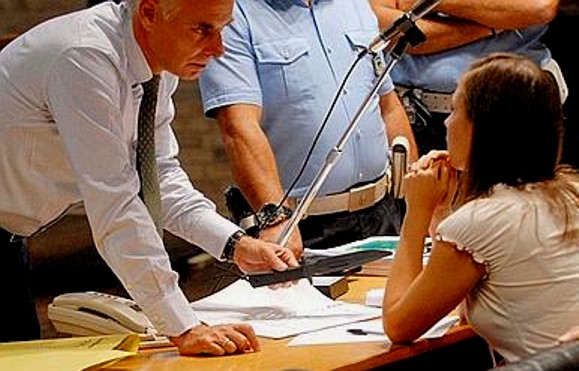
Lab work is believed to have continued today in the absence of the defense observers, and will continue on and off through to October 30th.
The defense observers may not have a further role at the laboratory. Most or all of the analysis leading to firm attributions of the DNA will be done by the Carabinieri team electronically.
It is that final attribution that the defenses are widely rumored to be so terrified of. That Knox’s DNA is there seems a given. The cliffhanger is whether Meredith’s DNA is there also.
Another possible mixed trace. If so it would be the sixth one.
Judge Massei did not arrive at a full scenario for how the five mixed blood traces at the crime scene could have been created. He described what was found by crime scene investigators and moved on.
After the 2009 Massei trial some further analysis was conducted.
With great help from Luciano Garofano’s DNA chapter in Darkness Descending and Barbie Nadeau’s and Andrea Vogt’s excellent reporting, we posted a comprehensive update mid-2011.
The locations of the five mixed traces at the crime scene are as follows.
1. Bathroom near Meredith’s room:
- On the drain of the bidet
- On the Q-tip box located at the ledge of the sink
- On the edge of the sink
Elsewhere in the apartment:
- In a luminol-enhanced bare footprint in the hallway outside Kercher’s room
- In a luminol-enhanced spot found in Filomena Romanelli’s room
Three sources for Knox’s blood have long been suggested: some bleeding from her ear, some bleeding from a possible nosebleed, some bleeding from the open scrape on her neck. .
All three of them could theoretically have been inflicted by Meredith as she struggled with the trio to save her life. None seem to explain why there were repeated MIXED traces.
That has remained a huge puzzle. But now we are looking at a fourth scenario: that Knox cut her hand with the top end of the blade as she stabbed at Meredith’s neck.
That could explain once and for all where Amanda Knox’s blood came from AND why it was mixed with Meredith’s blood. It happened right there.
[Click for larger image. Handle as from the blade direction. Sample is apparently from gap on sharp side.]


